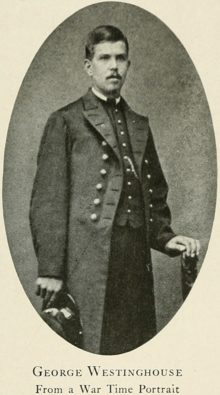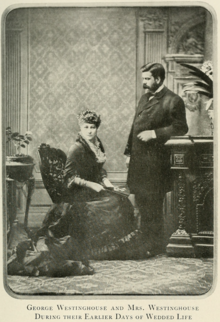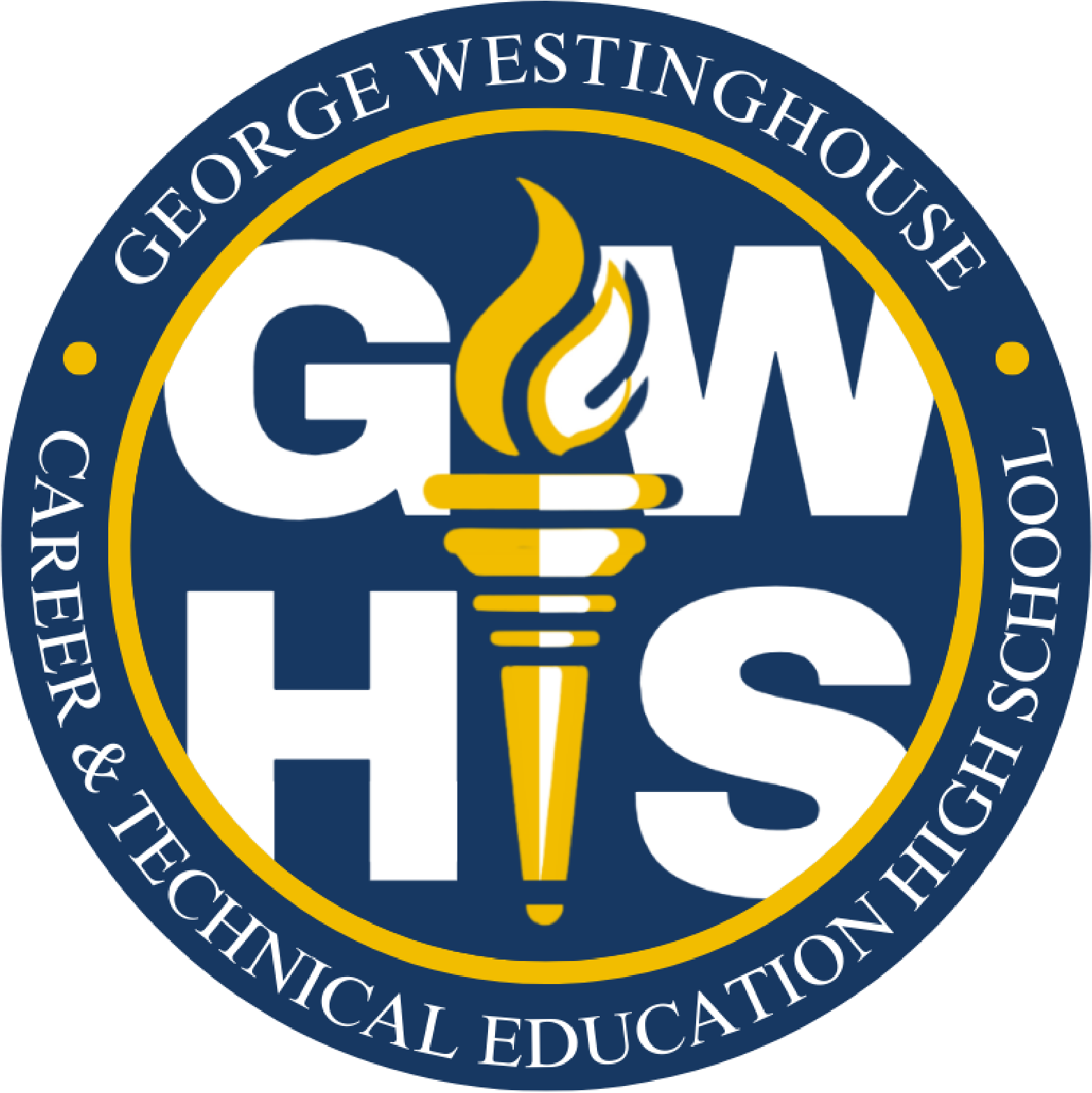George Westinghouse
Inventor, Businessman, & Entrepreneur
George Westinghouse was born on October 6, 1846 and died on March 12, 1914. He was a prolific American inventor, engineer, and entrepreneurial industrialist based in Pittsburgh, Pennsylvania. He is best known for his creation of the railway air brake and for being a pioneer in the development and use of alternating current (AC) electrical power distribution. During his career, he received 362 patents for his inventions and established 61 companies, many of which still exist today.
His invention of a train braking system using compressed air revolutionized the railroad industry around the world. He founded the Westinghouse Air Brake Company in 1869. He and his engineers also developed track-switching and signaling systems, which lead to the founding of the company Union Switch & Signal in 1881.
In the early 1880s, he developed inventions for the safe production, transmission, and use of natural gas. This sparked the creation of a whole new energy industry.
During this same period, Westinghouse recognized the potential of using alternating current (AC) for electric power distribution. In 1886, he founded the Westinghouse Electric Corporation. Westinghouse's electric business directly competed with Thomas Edison's, who was promoting direct current (DC) electricity. Westinghouse Electric won the contract to showcase its AC system to illuminate the "White City" at the 1893 Columbian Exposition in Chicago. The company went on to install the world's first large-scale, AC power generation plant at Niagara Falls, New York, which opened in August 1895.
source: wikipedia


Early Life
George Westinghouse Jr. was born on October 6, 1846, in Central Bridge, New York, to George Westinghouse Sr. and Emeline Vedder. His father owned a machinery shop where he manufactured agricultural equipment, particularly threshing machines and other farm implements. This early exposure to machinery would prove pivotal in shaping young George's future.
The family moved to Schenechtady, New York when George was around ten years old. His father established G. Westinghouse & Co., which manufactured various agricultural machinery and small steam engines. Young George spent much of his childhood and teenage years in his father's shop, where he learned machining, casting, and the fundamentals of mechanical engineering. By age 15, he could operate most of the machinery in the shop and showed remarkable aptitude for mechanical problems.
His formal education was somewhat limited and sporadic. He attended public school but was more interested in mechanical work than traditional academics. In fact, his father often complained that George spent too much time tinkering in the shop instead of focusing on his studies. However, this hands-on experience proved invaluable for his future career.
During the Civil War, at age 17, Westinghouse enlisted in the New York National Guard, serving as a cavalryman. He later joined the Union Navy in 1864, serving as Acting Third Assistant Engineer on the USS Muscoota. His military service exposed him to various mechanical systems and steam engines, further developing his technical knowledge.
The war proved to be transformative for young Westinghouse. During his service, he invented a device for putting derailed railroad cars back on their tracks. While this wasn't his first invention (he had already created a rotary steam engine), it marked his initial foray into railroad equipment, which would later become a crucial part of his career.
After the war, he attended Union College for about three months but dropped out, finding the theoretical approach less engaging than practical engineering. In 1865, he returned to his father's shop and invented a device for turning logs into fence posts. This was the first patent he actually brought to market, though it wasn't particularly successful.
One often-overlooked aspect of his early life was his marriage to Marguerite Erskine Walker in 1867, when he was just 21. She would prove to be not just a life partner but also a valuable business confidante throughout his career. They had one son, George Westinghouse III.
A pivotal moment came in 1866 when Westinghouse witnessed a train wreck caused by the inability of trains to brake quickly. This experience led him to begin thinking about improving railroad safety, eventually resulting in his breakthrough invention of the air brake in 1869, when he was only 22 years old.



Inventions & Innovations
Westinghouse learned machinery and engineering in his father's agricultural machinery shop. During the Civil War, he served in both the Union Army and Navy, which exposed him to various mechanical systems. His first patent came at age 19 for a rotary steam engine, though it proved commercially unsuccessful.
What made Westinghouse unique was his approach to invention——his research and development philosophy. For example, He:
- Maintained extensive research facilities
- Encouraged collaborative innovation among his engineers
- Actively sought out and purchased promising patents to improve upon
- Focused on practical applications rather than just theoretical advances
- Consistently worked to improve and refine his inventions over time
Air Brake System (1869)
The air brake was perhaps his most revolutionary invention. The Westinghouse Air Brake Company was his first major business venture. The air brake used compressed air to activate brake shoes on all cars simultaneously, replacing the dangerous manual braking system that required brakemen to run atop moving trains. This invention became mandatory equipment on all American trains by 1893.
He continued to improve railroad technology with the automatic rail signal system (1881), which used compressed air and electricity to coordinate railroad signals. These innovations led to the establishment of the Union Switch and Signal Company.Westinghouse's air brake used compressed air to:
- Create pressure that would automatically engage the brakes
- Release the brakes when pressure dropped
- Allow for graduated braking control
- Provide fail-safe operation (brakes would automatically engage if air pressure was lost)
He continued improving this system over the years with innovations like:
- The triple valve (1872), which allowed for faster brake response
- The automatic air brake (1874), which improved safety by automatically engaging brakes if cars separated
- The quick-action brake (1887), enabling nearly simultaneous braking across all cars
Railroad Signaling Systems (1881)
He developed a comprehensive railroad signaling system that included:
- Compressed air-powered switches
- Electric track circuits to detect trains
- Interlocking signals to prevent collisions
- Automatic block signaling systems
AC Power System Innovations
In the 1880s, Westinghouse became fascinated with electricity and power distribution. After learning about European developments in alternating current (AC), he purchased Gaulard and Gibbs' patents for AC transformers in 1885. He then established the Westinghouse Electric Company (later Westinghouse Electric & Manufacturing Company) to develop AC power systems.
He hired several brilliant engineers, including Nikola Tesla, whose AC motor patents he purchased. This team developed the first practical AC power system, which could transmit electricity over long distances more efficiently than Edison's direct current (DC) system. While not the original inventor of AC power, Westinghouse made crucial improvements and innovations:
- Developed more efficient transformers for power distribution
- Created improved insulation methods for high-voltage transmission
- Invented a DC meter for measuring electricity consumption
- Developed circuit breakers for high-voltage systems
- Created new designs for AC generators and motors
Natural Gas Innovations
In 1883, a natural gas well was discovered near his Pittsburgh home. Westinghouse immediately saw its potential and developed several innovations for the safe distribution of natural gas, including a safety cutoff valve and improved piping systems. He founded the Philadelphia Company to provide natural gas to Pittsburgh industries and homes. Following the discovery of natural gas in Pittsburgh, he invented:
- A device for measuring gas flow
- A safety cutoff valve to prevent gas leaks
- An improved method for transporting natural gas through pipelines
- A system for reducing gas pressure for home use
- A gas meter for accurate consumption measurement
Steam Engine Improvements
Throughout his career, he made several advances in steam power:
- Steam turbine designs for power generation
- Improved steam engine governors
- Enhanced rotary steam engine designs
- Steam-powered air compressors
Other Notable Inventions
- Air spring (1910): A pneumatic suspension system for vehicles
- Gearing system for electric streetcars
- Water meter for measuring municipal water usage
- Various pump designs for different industrial applications
- Improved methods for transmitting electrical power underwater
Lesser-Known Inventions
- A machine for replacing derailed cars (1865)
- A reversible frog (railroad track component) allowing trains to switch tracks more safely
- A pipe coupling for natural gas lines that became an industry standard
- An improved friction draft gear for railroad cars
- A system for purifying natural gas
Entrepreneurial Leadership
At its peak, Westinghouse's business empire included over 60 companies employing 50,000 workers. Major achievements included:
- Winning the contract to illuminate the 1893 World's Columbian Exposition in Chicago, demonstrating AC power's superiority
- Installing the first major hydroelectric power plant at Niagara Falls in 1895
- Developing the first steam turbine in America for electricity generation
- Creating the air spring for vehicle suspension
- Establishing international companies in Europe
Westinghouse was notable for his progressive labor relations. For example, he:
- Introduced 9-hour workdays when 10-12 was standard
- Implemented half-day Saturdays
- Provided employee benefits including: accident insurance, retirement pensions, and employee relief programs
- Maintained relatively peaceful labor relations during an era of intense industrial conflict
Westinghouse was also known for his innovative management approaches:
- Emphasized research and development
- Maintained personal relationships with key employees
- Offered profit-sharing programs
- Provided good working conditions and benefits
- Encouraged technical innovation at all levels
- Kept active involvement in technical decisions
- Corporate research laboratories
- Established the practice of hiring scientists and academics for industrial research——a model later adopted by companies like GE, Bell Labs, and other tech companies.
The Panic of 1907 led to financial difficulties, and Westinghouse lost control of many of his companies. However, he continued inventing, ultimately accumulating 361 patents across various fields.
Business Empire Development
Westinghouse had a remarkable ability to transform inventions into successful companies. His first major company, Westinghouse Air Brake Company (WABCO), established in 1869, exemplified his business approach. He:
- Raised initial capital through Pittsburgh investors
- Established a manufacturing facility in Pittsburgh's Strip District
- Created a strong patent portfolio to protect his innovations
- Established cross-licensing agreements with competitors
- Built relationships with major railroad companies
- His approach to IP management influenced modern technology licensing
- Expanded internationally, starting with European operations in 1881
Companies Founded
Westinghouse Electric & Manufacturing Company (1886)
- Initially focused on transformers and AC system development
- Expanded into electric lighting, generation, and transmission
- Acquired Tesla's patents for polyphase AC motors
- Became his largest and most significant enterprise
- Established research facilities that attracted top engineering talent
Philadelphia Company (1884)
- Focused on natural gas distribution
- Developed extensive pipeline networks in Pittsburgh
- Expanded into street railways and electric utilities
- Became one of the largest utilities in Pennsylvania
Union Switch and Signal Company (1881)
- Developed railroad safety and signaling systems
- Combined pneumatic and electrical technologies
- Dominated the railroad signaling market
- Later expanded into general industrial controls
International Expansion
Westinghouse established numerous international operations, including:
- Westinghouse Electric (UK) Ltd
- Société Anonyme Westinghouse (France)
- Westinghouse Brake Company Ltd (UK)
- Operations in Germany, Russia, and other European countries
Westinghouse's Legacy
Impact on Industry
His business philosophy was notably progressive for the time. He introduced half-days on Saturdays, pensions for workers, and generally maintained good labor relations. He believed in empowering his engineers and creating collaborative work environments, which helped attract top talent.
His business innovations left lasting impacts including standardization of electrical systems; integration of research and manufacturing; international technology licensing; patent pooling arrangements, and the establishment of corporate research laboratories.
Impact on the Electrical Industry
- Established AC power as the dominant electrical system worldwide
- Created the model for modern electrical utilities
- Pioneered long-distance power transmission
- Developed the first comprehensive electrical grid systems
- Influenced how utilities structure their operations
Impact on the Railroad Industry
- Introduced mass production techniques for complex systems
- Developed quality control processes
- Created modular design approaches
- Established systematic testing procedures
- Developed systematic maintenance protocols
Impact on Manufacturing
- Transformed railroad safety through air brake standardization
- Created modern signaling and switching systems
- Established safety standards still used today
- Influenced railroad operational procedures
- Pioneered integrated manufacturing facilities
Impact on Corporate Structure & Management
- Created the modern multi-divisional corporate structure
- Established international business models
- Developed systems for managing multiple related companies
- Created procedures for technology transfer between divisions
- Established professional management systems
Impact on Labor Relations
- Shorter working hours became industry standard
- Employee benefits packages became more common
- Workplace safety considerations improved
- Professional development programs expanded
- Collaborative labor-management relations emerged
Impact on Education
- Established training programs for technical workers
- Created apprenticeship systems
- Supported engineering education
- Developed professional development pathways
- Influenced technical education curricula
Impact on Modern Business Practices
- Corporate research and development structures
- International technology licensing
- Strategic patent management
- Quality control systems
- Employee relations
- Safety standards development
- System integration approaches
- Standardization practices
The "Westinghouse Way" of doing business - emphasizing innovation, employee welfare, and systematic approaches to complex problems - influenced many aspects of modern industrial practice. His companies' successes demonstrated that treating workers well and investing in research could lead to sustainable business success, a lesson that influenced the development of modern corporate culture.
